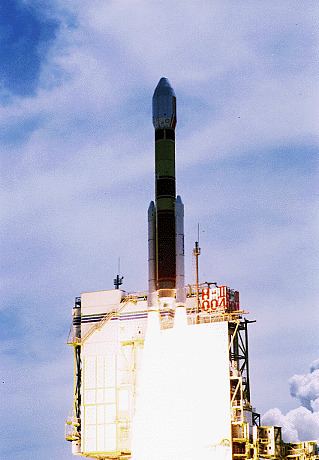Function Launch vehicle Height 49 m (161 ft) | Country of origin Japan Diameter 4 m (13 ft) | |
 | ||
Mass 260,000 kg (570,000 lb) | ||
The H-II (H2) rocket was a Japanese satellite launch system, which flew seven times between 1994 and 1999, with five successes. It was developed by NASDA in order to give Japan a capability to launch larger satellites in the 1990s. It was the first two-stage liquid-fuelled rocket Japan made using only technologies developed domestically. It was superseded by the H-IIA rocket following reliability and cost issues.
Contents
Background
Prior to H-II, NASDA had to use components licensed by the United States in its rockets. In particular, crucial technologies of H-I and its predecessors were from the Delta rockets. Although the H-I did have some domestically produced components, such as LE-5 engine on the second stage and inertial guidance system, the most crucial part, the first stage engine, was a licence-built version of the Thor-ELT of the US. By developing the LE-7 liquid-fuel engine and the solid booster rockets for the first stage, all stages of H-II had become "domestically developed".
The H-II was developed under the following policies, according to a NASDA press release:
- Develop the launch vehicle with Japanese space technology.
- Reduce both development period and costs by utilizing developed technologies as much as possible.
- Develop a vehicle which can be launched from the existing Tanegashima Space Center.
- Use design criteria which allows sufficient performance for both the main systems and subsystems. Ensure that development will be carried out properly, and safety is taken into account.
History
Development of the LE-7 engine which started in 1984 was not without hardships, and a worker died in an accidental explosion. The first engine was completed in 1994, two years behind the original schedule. In 1990, Rocket System Corporation was established to operate the launch missions after the rockets' completion.
In 1994, NASDA succeeded in launching the first H-II rocket, and succeeded in five launches by 1997. However, each launch cost 19 billion yen (190 million USD), too expensive compared to international competitors like Ariane. (This is in part due to the changes in exchange rates, which was 240 yen to a dollar when the project planning started in 1982, but had changed to 100 yen a dollar by 1994.) Development of the next-generation H-IIA rockets started in order to minimize launch costs.
The successive failure of flight 5 in 1998 and flight 8 in the following year brought an end to the H-II series. To investigate the cause of the failure and to direct resources into the H-IIA, NASDA cancelled flight 7 (which was to be launched after F8 due to changes in schedule), and terminated the H-II series.
H-II flights
note 1. ^ Faulty brazing in second-stage engine cooling system caused engine burn through and cable damage resulting in shutdown midway through the upper stage's second burn, leaving spacecraft in elliptical LEO instead of GTO. Spacecraft thrusters raised orbit enough to complete some communications experiments.
note 2. ^ Cavitation in the first stage hydrogen turbopump impeller caused an impeller blade to fracture, resulting in loss of fuel and rapid shutdown of the engine at T+239 s. The vehicle impacted the ocean 380 km NW of Chichi-jima.
